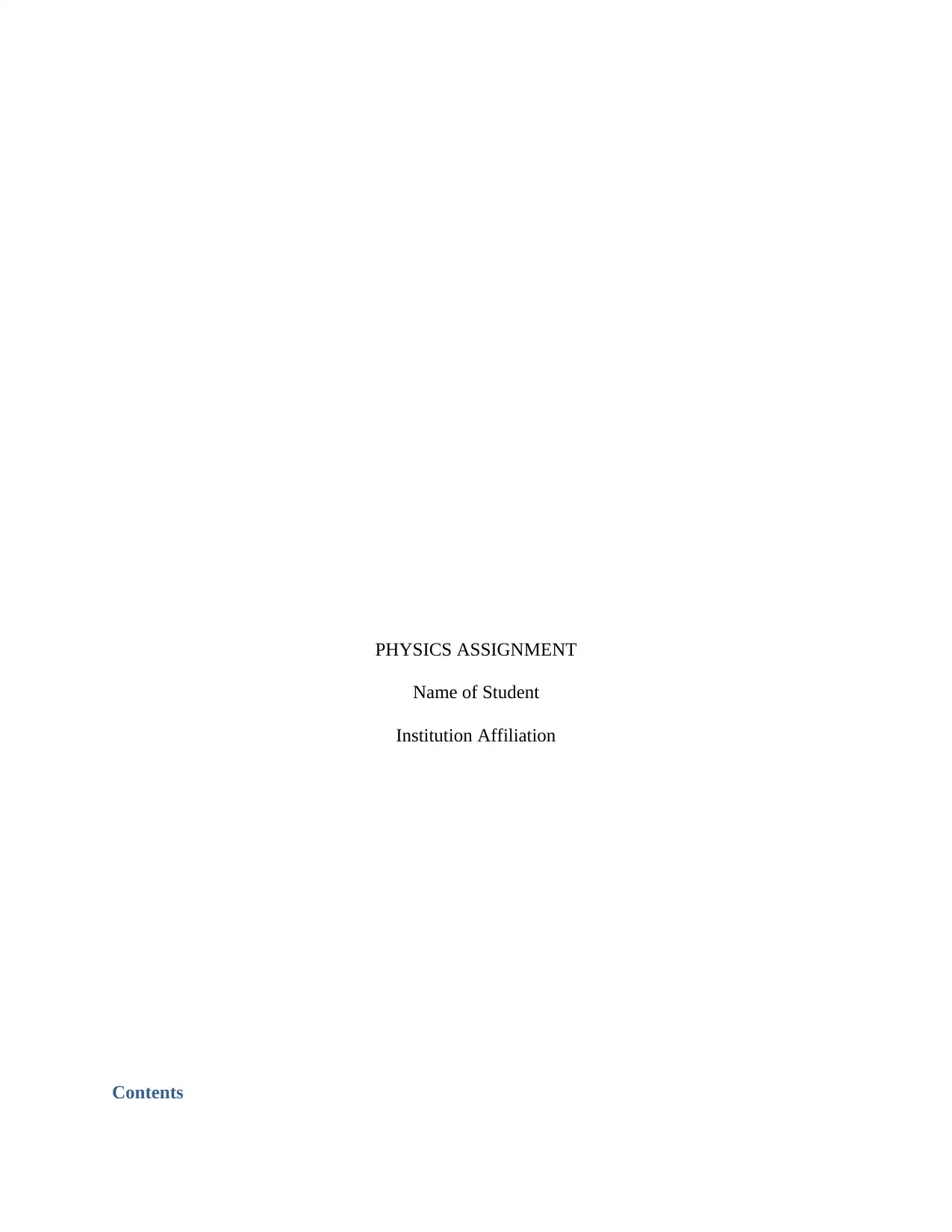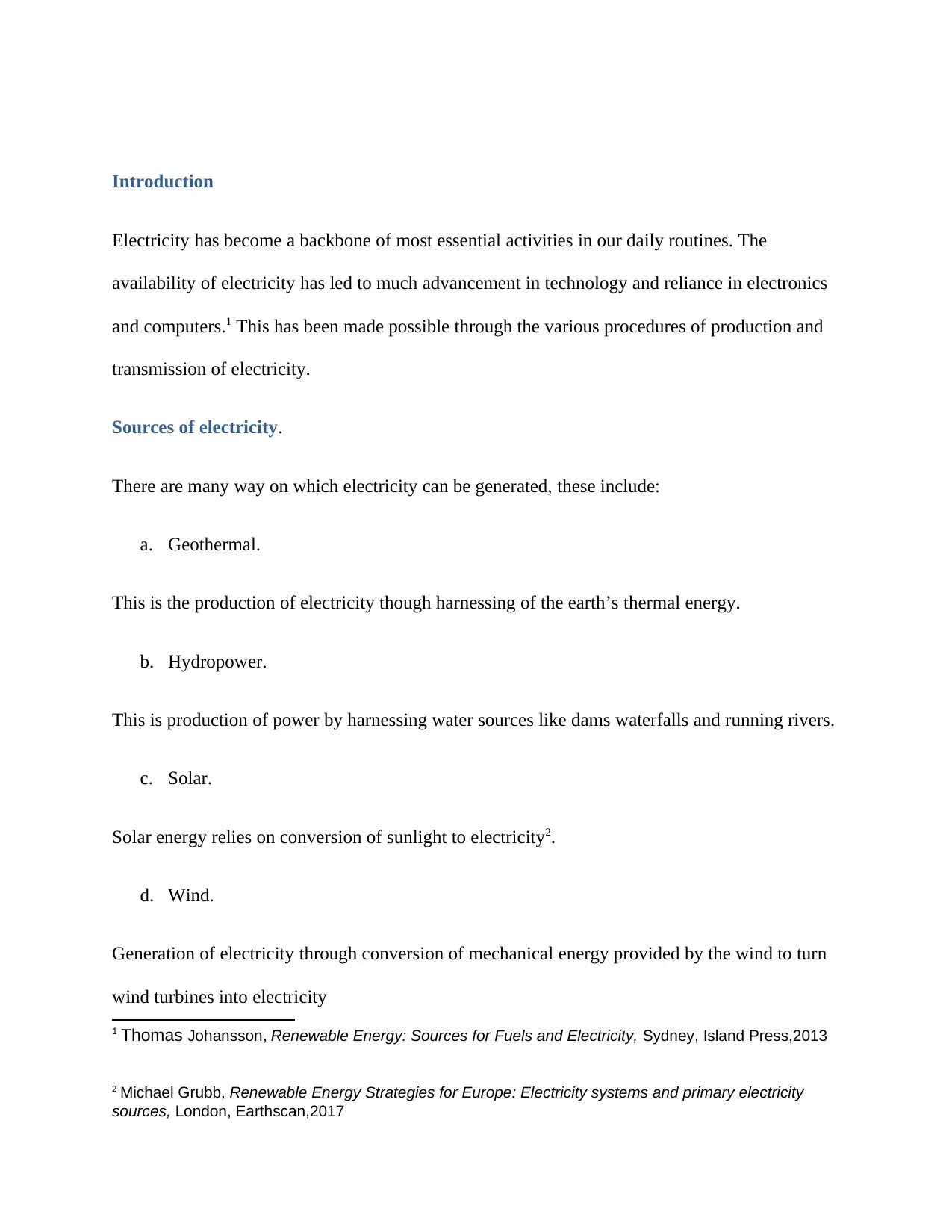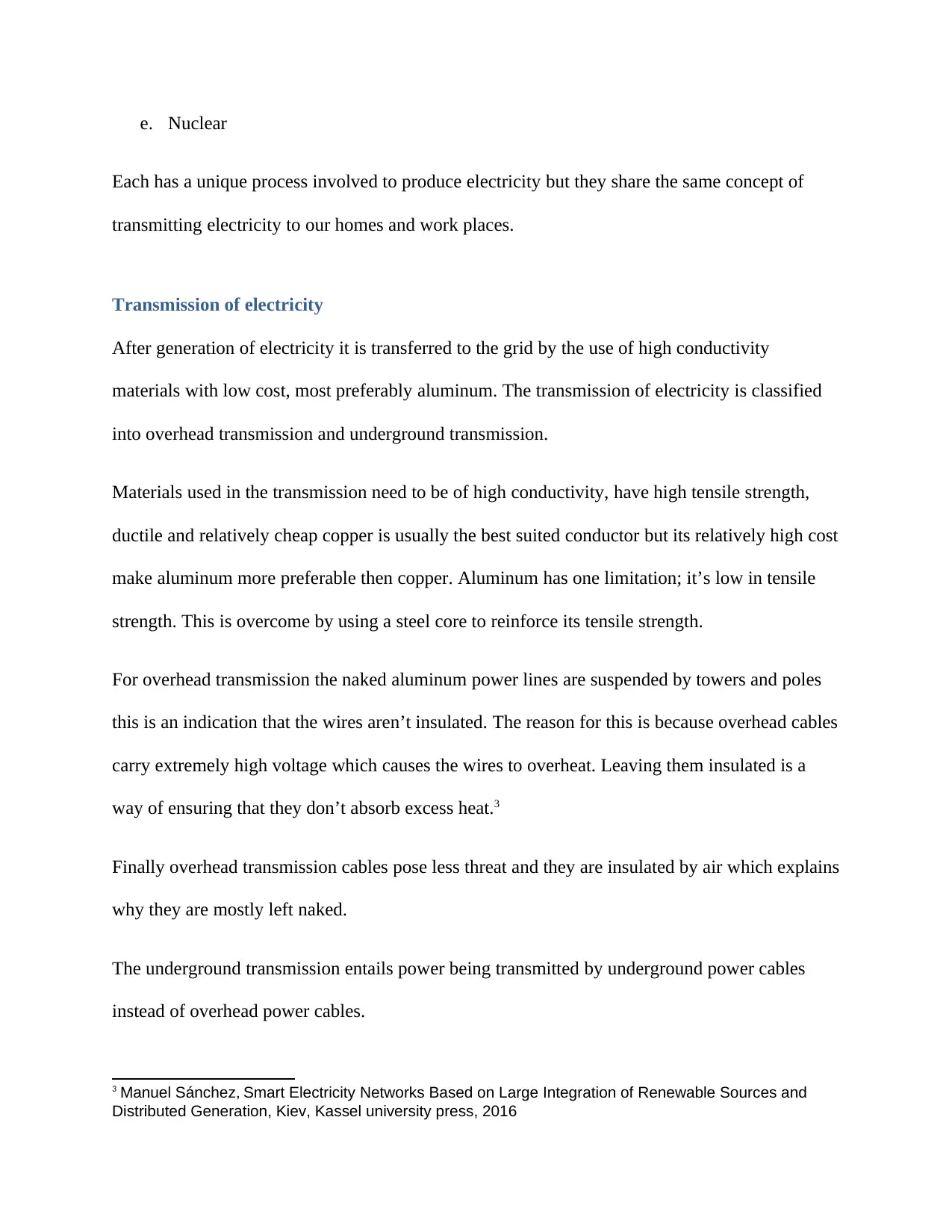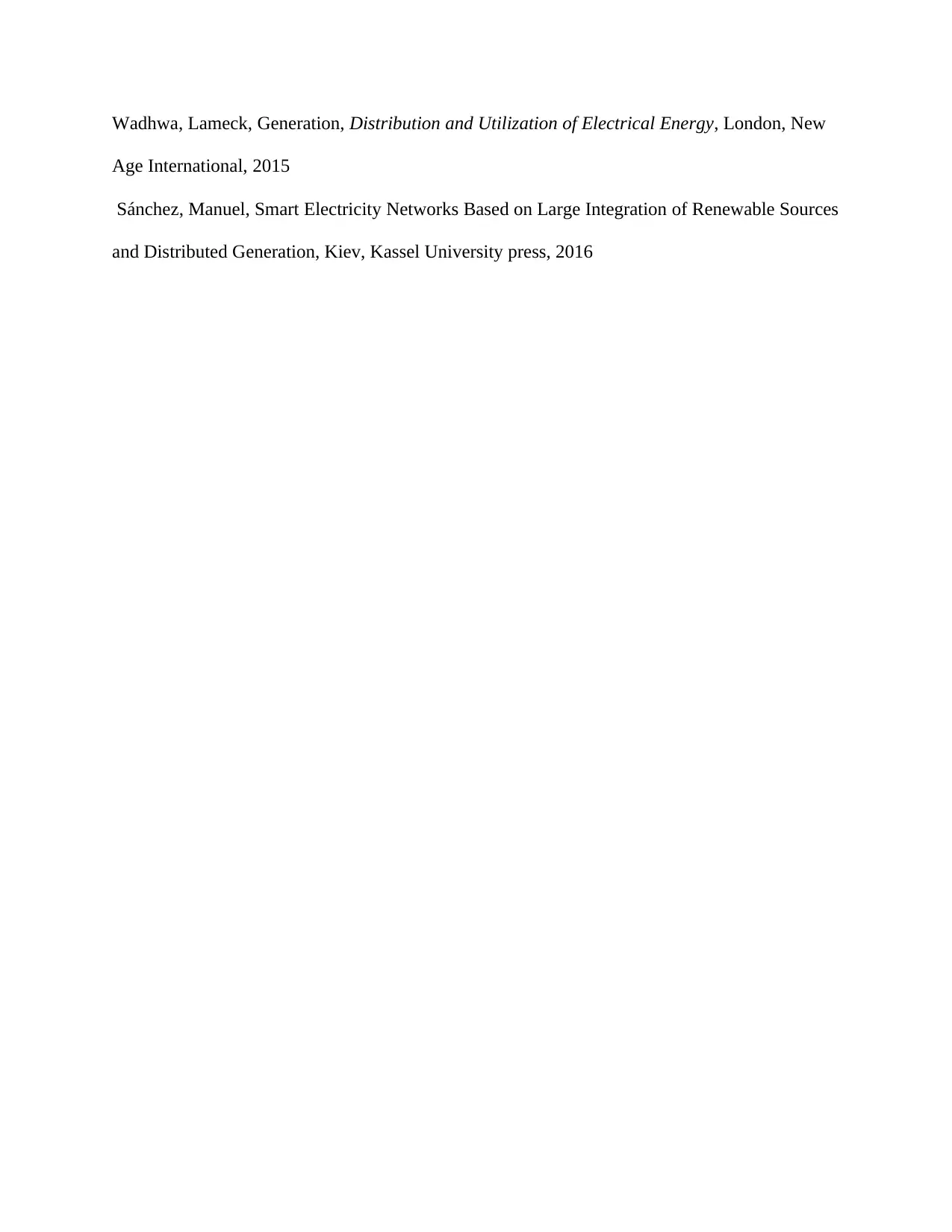Physics Assignment: Electricity Sources and Transmission - Physics 101
VerifiedAdded on 2023/01/17
|7
|761
|65
Homework Assignment
AI Summary
This physics assignment provides an overview of electricity, emphasizing its importance in modern life. It explores various sources of electricity generation, including geothermal, hydropower, solar, wind, and nuclear energy. The assignment then details the process of electricity transmission, discussing overhead and underground transmission methods, the use of high-conductivity materials like aluminum, and the role of transformers and substations in stepping up and down voltage levels. The journey of electricity from power stations to homes and workplaces is outlined, highlighting the complexity and refinement of the transmission process. The assignment references several sources, providing further reading on renewable energy strategies and electricity generation and distribution. The assignment concludes by summarizing the key stages involved in the electricity transmission process.

PHYSICS ASSIGNMENT
Name of Student
Institution Affiliation
Contents
Name of Student
Institution Affiliation
Contents
Paraphrase This Document
Need a fresh take? Get an instant paraphrase of this document with our AI Paraphraser

Introduction......................................................................................................................................3
Sources of electricity.......................................................................................................................3
Transmission of electricity..............................................................................................................4
Conclusion.......................................................................................................................................5
References........................................................................................................................................6
Sources of electricity.......................................................................................................................3
Transmission of electricity..............................................................................................................4
Conclusion.......................................................................................................................................5
References........................................................................................................................................6

Introduction
Electricity has become a backbone of most essential activities in our daily routines. The
availability of electricity has led to much advancement in technology and reliance in electronics
and computers.1 This has been made possible through the various procedures of production and
transmission of electricity.
Sources of electricity.
There are many way on which electricity can be generated, these include:
a. Geothermal.
This is the production of electricity though harnessing of the earth’s thermal energy.
b. Hydropower.
This is production of power by harnessing water sources like dams waterfalls and running rivers.
c. Solar.
Solar energy relies on conversion of sunlight to electricity2.
d. Wind.
Generation of electricity through conversion of mechanical energy provided by the wind to turn
wind turbines into electricity
1 Thomas Johansson, Renewable Energy: Sources for Fuels and Electricity, Sydney, Island Press,2013
2 Michael Grubb, Renewable Energy Strategies for Europe: Electricity systems and primary electricity
sources, London, Earthscan,2017
Electricity has become a backbone of most essential activities in our daily routines. The
availability of electricity has led to much advancement in technology and reliance in electronics
and computers.1 This has been made possible through the various procedures of production and
transmission of electricity.
Sources of electricity.
There are many way on which electricity can be generated, these include:
a. Geothermal.
This is the production of electricity though harnessing of the earth’s thermal energy.
b. Hydropower.
This is production of power by harnessing water sources like dams waterfalls and running rivers.
c. Solar.
Solar energy relies on conversion of sunlight to electricity2.
d. Wind.
Generation of electricity through conversion of mechanical energy provided by the wind to turn
wind turbines into electricity
1 Thomas Johansson, Renewable Energy: Sources for Fuels and Electricity, Sydney, Island Press,2013
2 Michael Grubb, Renewable Energy Strategies for Europe: Electricity systems and primary electricity
sources, London, Earthscan,2017
⊘ This is a preview!⊘
Do you want full access?
Subscribe today to unlock all pages.

Trusted by 1+ million students worldwide

e. Nuclear
Each has a unique process involved to produce electricity but they share the same concept of
transmitting electricity to our homes and work places.
Transmission of electricity
After generation of electricity it is transferred to the grid by the use of high conductivity
materials with low cost, most preferably aluminum. The transmission of electricity is classified
into overhead transmission and underground transmission.
Materials used in the transmission need to be of high conductivity, have high tensile strength,
ductile and relatively cheap copper is usually the best suited conductor but its relatively high cost
make aluminum more preferable then copper. Aluminum has one limitation; it’s low in tensile
strength. This is overcome by using a steel core to reinforce its tensile strength.
For overhead transmission the naked aluminum power lines are suspended by towers and poles
this is an indication that the wires aren’t insulated. The reason for this is because overhead cables
carry extremely high voltage which causes the wires to overheat. Leaving them insulated is a
way of ensuring that they don’t absorb excess heat.3
Finally overhead transmission cables pose less threat and they are insulated by air which explains
why they are mostly left naked.
The underground transmission entails power being transmitted by underground power cables
instead of overhead power cables.
3 Manuel Sánchez, Smart Electricity Networks Based on Large Integration of Renewable Sources and
Distributed Generation, Kiev, Kassel university press, 2016
Each has a unique process involved to produce electricity but they share the same concept of
transmitting electricity to our homes and work places.
Transmission of electricity
After generation of electricity it is transferred to the grid by the use of high conductivity
materials with low cost, most preferably aluminum. The transmission of electricity is classified
into overhead transmission and underground transmission.
Materials used in the transmission need to be of high conductivity, have high tensile strength,
ductile and relatively cheap copper is usually the best suited conductor but its relatively high cost
make aluminum more preferable then copper. Aluminum has one limitation; it’s low in tensile
strength. This is overcome by using a steel core to reinforce its tensile strength.
For overhead transmission the naked aluminum power lines are suspended by towers and poles
this is an indication that the wires aren’t insulated. The reason for this is because overhead cables
carry extremely high voltage which causes the wires to overheat. Leaving them insulated is a
way of ensuring that they don’t absorb excess heat.3
Finally overhead transmission cables pose less threat and they are insulated by air which explains
why they are mostly left naked.
The underground transmission entails power being transmitted by underground power cables
instead of overhead power cables.
3 Manuel Sánchez, Smart Electricity Networks Based on Large Integration of Renewable Sources and
Distributed Generation, Kiev, Kassel university press, 2016
Paraphrase This Document
Need a fresh take? Get an instant paraphrase of this document with our AI Paraphraser

In the transmission of electricity step up transformers are used to enable the transmission over
long distances. During this process of transmission electricity goes through substations where it
is transformed from high voltage to low voltage or low voltage to high voltage. Substations also
include transformers which convert voltage levels between high transmission voltages and lower
distribution voltages.
The power from the substations is then through transmission and distribution power lines carried
over long distances to nearest place where needed, here distribution transformers mounted on
distribution poles step down the voltage to the desired consumer level. This is the final stage
where the electricity is delivered to our homes and work places4.
Fig 1: Voltage figure.
Conclusion.
The process of electricity transmission from the power station to our homes and work place is a
much more complex and detailed procedure though n its simplified forms it seems so easy and
undemanding.
4 Lameck Wadhwa, Generation, Distribution and Utilization of Electrical Energy, London, New Age
International,2015
long distances. During this process of transmission electricity goes through substations where it
is transformed from high voltage to low voltage or low voltage to high voltage. Substations also
include transformers which convert voltage levels between high transmission voltages and lower
distribution voltages.
The power from the substations is then through transmission and distribution power lines carried
over long distances to nearest place where needed, here distribution transformers mounted on
distribution poles step down the voltage to the desired consumer level. This is the final stage
where the electricity is delivered to our homes and work places4.
Fig 1: Voltage figure.
Conclusion.
The process of electricity transmission from the power station to our homes and work place is a
much more complex and detailed procedure though n its simplified forms it seems so easy and
undemanding.
4 Lameck Wadhwa, Generation, Distribution and Utilization of Electrical Energy, London, New Age
International,2015

This procedure has over the years been perfected and is still having more inventions and
innovations adding into it. Its impact on live has been evident mostly in the 21st century.
References
Grubb, Michael, Renewable Energy Strategies for Europe: Electricity systems and primary
electricity sources, London, Earthscan, 2017
Johansson, Thomas, Renewable Energy: Sources for Fuels and Electricity, Sydney, Island Press,
2013
innovations adding into it. Its impact on live has been evident mostly in the 21st century.
References
Grubb, Michael, Renewable Energy Strategies for Europe: Electricity systems and primary
electricity sources, London, Earthscan, 2017
Johansson, Thomas, Renewable Energy: Sources for Fuels and Electricity, Sydney, Island Press,
2013
⊘ This is a preview!⊘
Do you want full access?
Subscribe today to unlock all pages.

Trusted by 1+ million students worldwide

Wadhwa, Lameck, Generation, Distribution and Utilization of Electrical Energy, London, New
Age International, 2015
Sánchez, Manuel, Smart Electricity Networks Based on Large Integration of Renewable Sources
and Distributed Generation, Kiev, Kassel University press, 2016
Age International, 2015
Sánchez, Manuel, Smart Electricity Networks Based on Large Integration of Renewable Sources
and Distributed Generation, Kiev, Kassel University press, 2016
1 out of 7
Related Documents
Your All-in-One AI-Powered Toolkit for Academic Success.
+13062052269
info@desklib.com
Available 24*7 on WhatsApp / Email
![[object Object]](/_next/static/media/star-bottom.7253800d.svg)
Unlock your academic potential
Copyright © 2020–2025 A2Z Services. All Rights Reserved. Developed and managed by ZUCOL.



